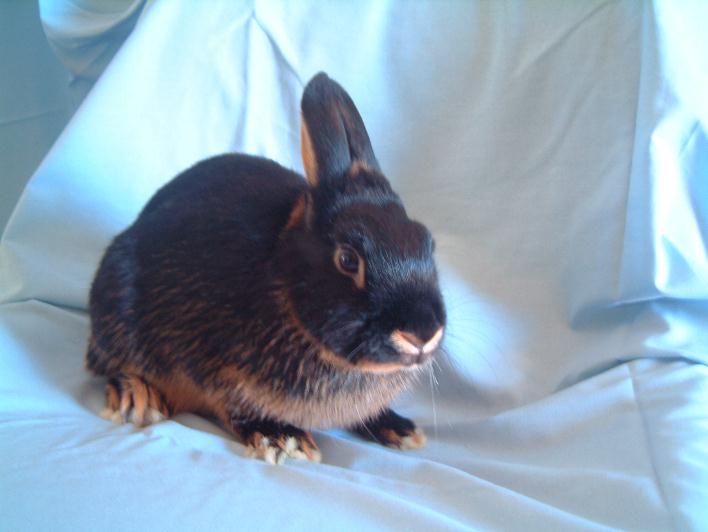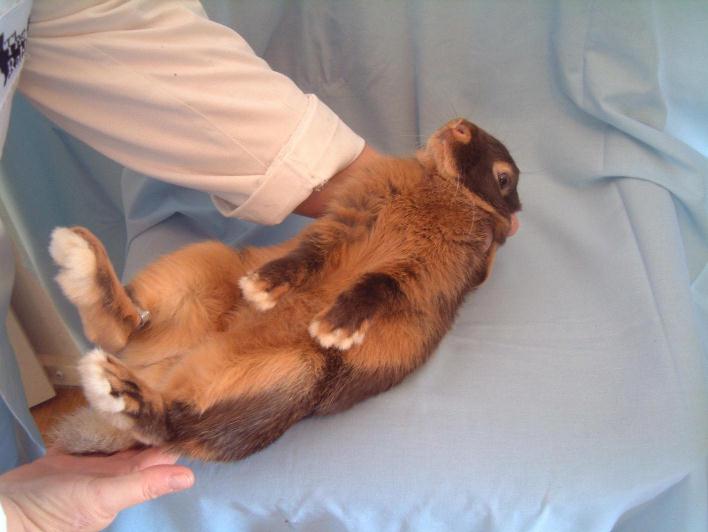



TAN RABBIT - Nikki White (Reguli Cavy & Rabbit Stud)
Despite being one of the most popular show breeds in the UK (where it has topped the Best in Show charts for six years running), this breed is quite rare out here. Indeed, for a while it was thought to be extinct. However, thanks to the dedication of a few breeders like Vija Hone they have become available again though are still rare.
This is an elegant Fancy breed. The basic pattern is a solid body colour with rich tan markings on the inner part of the hind legs, chest, belly, flanks, eye circles, inside the ears and on the triangle on the nape. Think Doberman Pincher with long ears and a compact body as far as the Black and Tans go. Black is the most popular colour. In fact the BRC Breed Standard says no other colour but Black and Tan – then contradicts itself by describing, under ‘Coat’, Blue and Tan, Chocolate and Tan and Lilac and Tan! All these colours are acceptable, having been around for quite a while. The standard states the coat should be free of any brindling except at the sides which should be well ticked with long tan hairs. The tan part should not be sooty or have body coloured hairs. The ears should be short, fine and erect and close together; the body shape short and cobby, the body topline should arch gracefully and moderately from the nape to the base of the tail. The fur should be silky. They are a small rabbit, weighing around 2kg. Penalties include brindling, white or grey hairs in the body colour, white ear edges, an indistinct line of division between the tan and the body colour on the flanks or hind legs. Disqualifications are putty nose, white tufts in the armpits and deformities.
HISTORY
A Mr Cox of Brailsford, Derbyshire, bred them from offspring produced by a colony of wild rabbits mixed with Dutch-type tame rabbits in the 1880s. The original Tans were ill-tempered and holy terrors judges preferred to avoid as they were a bit too handy with their teeth (definitely UTJ if not UTH). A little later a larger version was created by a Mr Purnell of Cheltenham who crossed Black and Tans with Belgian Hares. They had a quieter nature even if they did split the fancy as two separate clubs were formed, one around the Brailsford type and the other around the Cheltenham. Eventually, the two types amalgamated to form a rabbit not exceeding 5lbs in weight with a short cobby body with nicer natures and happy to be handled. One club folded leaving just the one which under a slightly different name is still in existence today. As early as 1894 Tans were considered good house rabbits and there are accounts of them running around the house and coming when called like a dog or a cat.
At the beginning of the 20th century, the Blue and Tan appeared, followed by the Chocolate in 1922 and the Lilac in 1933. The Tan was introduced into France in 1894 and Switzerland in 1900.
SO, A TAN THEN?
They make good pets as indicated above. They have a friendly nature and are generally docile. Some may be shy, some playful but very few are spiteful. Because they are small and compact, they are easy to handle and are considered suitable as children’s pets.
WHAT TO LOOK FOR
They have a stocky solid build, are well rounded with straight sturdy legs, a short neck and weigh around 2kg. The coat is fairly short, lies sleekly to the body and has a silky touch and a deep sheen. The colour markings should be clearly defined with a sharp edge to contrast between the self colour and the tan.
Baby Tans can look a mess with a pale tan, almost dirty white, and brindling on the face from nostrils to the ears and also the forelegs. Gradually, however, they will lose the brindling and the tan will deepen to its true colour as they develop. The coat will gain lustre and lose its fluffiness. This process can take 5 months or more. The slow clearers often prove to be the best rabbits.
CARE AND HANDLING
This is a small rabbit so requires a hutch 80-90 cm by 50-60 cm. Feed is as for other breeds - pellets, mix, fresh fruit and veg, as treats. Don't over feed. Their coats can be brought to a fine sheen by brushing with your hands and/or a piece of silk or satin cloth or mitt. Like all rabbits, they should be brushed with a slicker brush or comb in moult and given plenty of roughage (meadow hay or lucerne) during these times. They are basically an easy care rabbit.
ORGANISATIONS
American Tan Rabbit Speciality Club
FURTHER READING
British Rabbit Council, Standards of Rabbit Breeds 3rd ed. 2011-2016.
Brown, Meg & Richardson, Virginia, Rabbit Lopaedia. Lydney, Gloucestershire, Ringpress Books, 2000
Campbell, Darlene, The Proper Care of Rabbits, Neptune City, NJ, TFH, 1994
Howden, A. S., The Book of the Tan Rabbit. Chattisham, Fur & Feather for Coney Publications, 2011 (c. 1956)
Russell, Geoff, Mini Encyclopeda of Rabbit Breeds & Care. Dorking, Interpet Publishing, 2008
Sandford, J. C., The Domestic Rabbit. 5th ed. Oxford, Blackwell Science, 1996
Verhoef-Verhallen, Esther, Encyclopaedia of Rabbits and Rodents. Lisse, Rebo Productions, 1998
Vriends-Parent, Lucia, The New Rabbit Handbook. Hauppage, NY, Barrons, 1989
Whitman, Bob D., Domestic Rabbits & Their Histories: Breeds of the World. Leawood, KS : Leathers Publishing, 2004
Williams, A.E. Ted, Rabbit Breeding for Perfection. Melbourne, AE Williams, 1992.
"Breed profile no. 6: Tan" Fur and feather 3rd ser.,vol. 13, no. 8 (Jan. 2003) p. 8-10